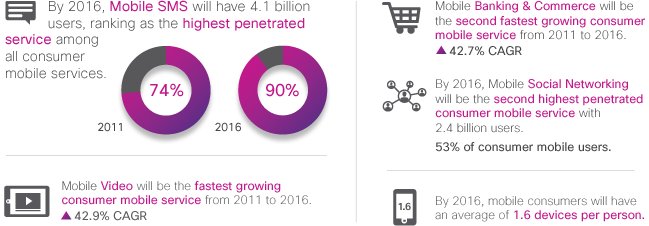Internet connectivity is nowhere near leveling off, according to an annual Cisco forecast, though future growth will be increasingly driven by mobile devices.
Researchers predict that the proliferation of phones and tablets will boost internet use, broadband speed and wi-fi availability worldwide, with a projected 3.4 billion internet users – and a staggering 18.9 billion internet connections – by 2016.
“In 2011, PCs generated 94 percent of consumer Internet traffic,” researchers wrote. “This contribution is expected to fall to 81 percent by 2016 – demonstrating the impact that an increasing number and variety of devices like tablets, smartphones, etc. are having on how consumers and businesses access and use the Internet.”
Global internet traffic will top 1.3 zettabytes – that’s one trillion gigabytes – in 2016, according to Cisco. In 2011, traffic was just .37 zettabytes.
In addition to mobile devices, that titanic increase in global bandwidth will be consumer adoption of internet video, including chat and streaming services. But that will be mainly on mobile and desktop devices: internet TVs will account for just six percent of total traffic, up from four percent today.
Concurrently, a new report by ABI Research says that the increasing reliance on phones for serious computing will lead to the rise of handsets that are larger than regular phones, but not quite as big as tablets. Presumably struggling to keep a straight face, ABI researchers are terming these devices – which include the Samsung Galaxy Note and Nexus – “phablets.”
ABI researchers actually see the phablet form factor as filling an important gap for users who expect more from their handsets, and their tiny screens, than was ever anticipated before the advent of smartphones.
“One of the chief drivers for phablets is the amount of time people use their smartphones for web browsing, reading articles and newspapers on the go, or simply navigating their journeys,” said senior analyst Joshua Flood, in a press release. “The larger screen sizes make a significant difference to the user’s experience when compared to conventional-sized touchscreens between 3.5 to 4 inches.”
Image: Cisco / Featured image: Warner Brothers







